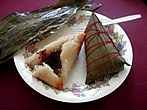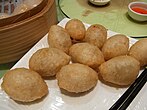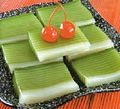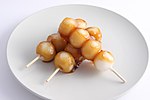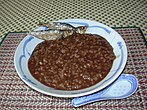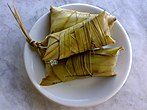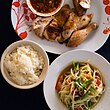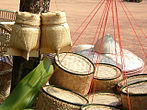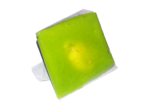Glutinous rice



Glutinous rice (Oryza sativa var. glutinosa; also called sticky rice, sweet rice or waxy rice) is a type of rice grown mainly in Southeast and East Asia, and the northeastern regions of South Asia, which has opaque grains, very low amylose content, and is especially sticky when cooked. It is widely consumed across Asia.
It is called glutinous (
History
The origin of glutinous rice is difficult to ascertain due to its long-standing cultural importance across a wide geographical region in Asia. It is most prevalent in the highland regions in Southeast Asia where it is a staple, while it also serves as occasional festival food in East Asia (mainly for desserts) and parts of South Asia. Glutinous rice is particularly associated with the upland agriculture of the Kra–Dai-speaking peoples of Mainland Southeast Asia. A region of around 200,000 km2 (77,000 sq mi) that includes Laos, Myanmar, Thailand, Cambodia, and Vietnam is sometimes known as the "glutinous rice zone."[2][3]
A 2002 genetic study discovered that the waxy mutation that disrupted amylose synthesis likely has a single origin. This is supported by the fact that all glutinous rice accessions in the study contain the same mutation. From comparisons of subsequent mutations in the different accessions in the study, it was found that the progenitor haplotype is highest among Southeast Asian glutinous rice cultivars, indicating strongly that the waxy mutation first arose in Southeast Asia, likely in the upland regions of Mainland Southeast Asia, before spreading to the rest of Asia.[2]
The waxy mutation is also known to have first arose in temperate
Cultivation
Glutinous rice is grown in Laos, Thailand, Cambodia, Vietnam, Malaysia, Indonesia, Myanmar, Nepal, Bangladesh, Bhutan, Northeast India, China, Japan, Korea, Taiwan, and the Philippines. An estimated 85% of Lao rice production is of this type.[5]
As of 2013, approximately 6,530 glutinous rice varieties were collected from five continents (Asia, South America, North America, Europe, and Africa) where glutinous rice is grown for preservation at the International Rice Genebank (IRGC).[6] The International Rice Research Institute (IRRI) has described Laos as a "collector's paradise".[7] Laos has the largest biodiversity of sticky rice in the world. IRRI-trained collectors gathered more than 13,500 samples and 3,200 varieties from Laos alone.[7]
Composition
Glutinous rice is distinguished from other types of rice by having no (or negligible amounts of) amylose and high amounts of amylopectin (the two components of starch). Amylopectin is responsible for the sticky quality of glutinous rice. The difference has been traced to a single mutation that farmers selected.[2][8]
Like all types of rice, glutinous rice does not contain dietary gluten (i.e. does not contain glutenin and gliadin) and should be safe for gluten-free diets.[9]
Glutinous rice can be used either milled or unmilled (that is, with the
Use in foods
This section needs additional citations for verification. (July 2021) |
Glutinous rice is used in a wide variety of traditional dishes in different countries. They include the following:
Bangladesh
In Bangladesh, especially in the eastern side (Chittagong, Cox's Bazaar, Sylhet areas), Glutinous rice is known as Binni chal (Bangla: বিন্নি চাল) or Binni choil (বিন্নি ছোইল) is husked sticky rice in Bangla. Both white and pink varieties are cultivated at many homestead farms. Unhusked sticky rice is called binni dhan. Boiled or steamed binni choil is called Binni Bhat. Served with a curry of fish or meat or grated coconut, Binni Bhat is a popular breakfast. Sometimes, it is eaten with a splash of palm sugar or cane sugar, salt, and coconut alone. Binni dhan is also used to make khoi (popcorn-like puffed rice) and chida (bitten husked rice).
Many other sweet items, or Pitha made of binni choil are also popular:
One pitha made of binni choil is "Atikka pitha". It is made with a mixture of cubed or small sliced coconut, white or brown sugar, (specifically date
Another delicacy is Patishapta pitha made of ground binni choil which is sprayed over a hot pan and then adding a mixture of grated coconut, palm sugar, and sometimes milk powder in the center to make a roll.
One kind of rice porridge made of bini choil is called Modhu bhat, which literally means "honey rice". It is made by cooking water, milk, and binni choil for a long time, slightly blending it, and then is topped off with coconut shreds. This is also a food known to the Chittagong area.
Cambodia

Glutinous rice is known as bay damnaeb (Khmer: បាយដំណើប) in Khmer.
In
China
In the Chinese language, glutinous rice is known as nuòmǐ (糯米) or chu̍t-bí (秫米) in Hokkien.
Glutinous rice is also often ground to make
Glutinous rice or glutinous rice flour are both used in many
Sweet glutinous rice is eaten with red bean paste.
Nuòmǐ fàn (糯米飯), is steamed glutinous rice usually cooked with Chinese sausage, chopped Chinese mushrooms, chopped barbecued pork, and optionally dried shrimp or scallop (the recipe varies depending on the cook's preference).
Zongzi (Traditional Chinese 糭子/糉子, Simplified Chinese 粽子) is a dumpling consisting of glutinous rice and sweet or savoury fillings wrapped in large flat leaves (usually bamboo), which is then boiled or steamed. It is especially eaten during the Dragon Boat Festival but may be eaten at any time of the year. It is popular as an easily transported snack, or a meal to consume while travelling. It is a common food among Chinese in Hong Kong, Singapore and Malaysia.
Cifangao (Traditional Chinese 糍飯糕, Simplified Chinese 糍饭糕) is a popular breakfast food originating in Eastern China consisting of cooked glutinous rice compressed into squares or rectangles, and then deep-fried.[13] Additional seasoning and ingredients such as beans, zha cai, and sesame seeds may be added to the rice for added flavour. It has a similar appearance and external texture to hash browns.
Cifantuan (Traditional Chinese 糍飯糰, Simplified Chinese 糍饭团) is another breakfast food consisting of a piece of youtiao tightly wrapped in cooked glutinous rice, with or without additional seasoning ingredients. Japanese onigiri resembles this Chinese food.
Lo mai gai (糯米雞) is a dim sum dish consisting of glutinous rice with chicken in a lotus-leaf wrap, which is then steamed. It is served as a dim sum dish in Hong Kong, Singapore, and Malaysia.
Ba bao fan (八寶飯), or "eight treasure rice", is a dessert made from glutinous rice, steamed and mixed with lard, sugar, and eight kinds of fruits or nuts. It can also be eaten as the main course.
A distinctive feature of the Cuisine of the Hakka people of Southern China is its variety of steamed snack-type buns, dumplings, and patties made with a dough of coarsely ground rice, or ban. Collectively known as "rice snacks", some kinds are filled with various salty or sweet ingredients.
Common examples of rice snacks made with ban from glutinous or sticky rice and non-glutinous rice[further explanation needed] include Aiban (mugwort patty), Caibao (yam bean bun), Ziba (sticky rice balls) and Bantiao (Mianpaban or flat rice noodles).
Aiban encompasses several varieties of steamed patties and dumplings of various shapes and sizes, consisting of an outer layer made of glutinous ban dough filled with salty or sweet ingredients. It gets its name from the aromatic ai grass (mugwort), which after being dried, powdered, and mixed with the ban, gives the dough a green colour and an intriguing tea-like taste. Typical salty fillings include ground pork, mushrooms, and shredded white turnips. The most common sweet filling is made with red beans.
Caibao is a generic term for all types of steamed buns with various sorts of filling. Hakka-style caibao are distinctive in that the enclosing skin is made with glutinous rice dough in place of wheat flour dough. Besides ground pork, mushrooms, and shredded turnips, fillings may include ingredients such as dried shrimp and dry fried-shallot flakes.
Ziba is glutinous rice dough that, after steaming in a big container, is mashed into a sticky, putty-like mass from which small patties are formed and coated with a layer of sugary peanut powder. It has no filling.
-
Glutinous zongzi rice dumplings, without and with bamboo leaf wrapping
-
Glutinous rice ball dessert, filled with sesame paste
-
Deep fried glutinous rice ball dumplings
-
Fried slices of Shanghai Nian cake
-
Chinese glutinous rice pancake or "Chinese pizza"
-
Ba bao fan
Indonesia
Glutinous rice is known as beras ketan or simply ketan in
Savoury snacks
- Ketan - traditionally refers to the glutinous rice itself as well as sticky rice delicacy in its simplest form. The handful mounds of glutinous rice are rounded and sprinkled with grated coconut, either fresh or sauteed as serundeng.
- Ketupat - square-shaped crafts made from the same local leaves as palas, but it is usually filled with regular rice grains instead of pulut, though it depends on the maker.
- Gandos - a snack made from ground glutinous rice mixed with grated coconut, and fried.
- Lemang - wrapped in banana leaves and inside a bamboo, and left to be barbecued/grilled on an open fire, to make the taste and texture tender and unique
- Lemper - cooked glutinous rice with shredded meat inside and wrapped in banana leaves, popular in Java
- Nasi kuning - either common rice or glutinous rice can be made into ketan kuning, yellow rice coloured with turmeric
- Songkolo or Sokko - steamed black glutinous rice serves with
- Tumpeng - glutinous rice can be made into tumpeng nasi kuning, yellow rice coloured by turmeric, and shaped into a cone.
Sweet snacks
- Variety of kue - glutinous rice flour is also used in certain traditional local desserts, known as kue, such as kue lapis.
- Bubur ketan hitam - black glutinous rice porridge with coconut milk and palm sugar syrup
- Cendil - glutinous rice flour cake with sugar and grated coconut
- Dodol - traditional sweets made of glutinous rice flour and coconut sugar. Similar variants include wajik (or wajit).
- Gemblong - white glutinous rice flour balls smeared with palm sugar caramel. In East Java, it was known as getas, except it uses black glutinous rice flour as the main ingredient.
- Jipang - popped glutinous rice held together by caramelized sugar
- Klepon - glutinous rice flour balls filled with palm sugar and coated with grated coconut
- Lupis - glutinous rice wrapped in individual triangles using banana leaves and left to boil for a few hours. The rice pieces are then tossed with grated coconut all over and served with palm sugar syrup.
- Jin deui
- Wingko babat - baked glutinous rice flour with coconut
Fermented snacks
- Brem - solid cake from the dehydrated juice of pressed fermented glutinous rice
- Tapai ketan - cooked glutinous rice fermented with yeast, wrapped in banana or roseapple leaves. Usually eaten as it is or in a mixed cold dessert
Crackers
- kerupuk
In addition, glutinous rice dishes adapted from other cultures are just as easily available. Examples include kue moci (
-
Lemper, glutinous rice filled with chicken wrapped in banana leaves
-
Dodol made from coconut sugar and ground glutinous rice
-
Ketan served with durian sauce
-
Uli bakar or grilled glutinous rice cube
-
Cendil a Javanese cake made of glutinous rice flour, sugar, and grated coconut
-
Kue lapis - Indonesian cake made mainly of glutinous rice
-
Kue lupis - Glutinous rice cake with grated coconut and liquid palm sugar
-
Tapai ketan (right) served with uli (glutinous rice cooked with grated coconut, and mashed; left)
Japan
In Japan, glutinous rice is known as mochigome (
Korea
In
Laos


Along the Greater Mekong Sub-region, the Lao have been cultivating glutinous rice for approximately 4000 – 6000 years.[6] Glutinous rice is the national dish of Laos.[14] In Laos, a tiny landlocked nation with a population of approximately 6 million, per-capita sticky rice consumption is the highest on earth at 171 kg or 377 pounds per year.[15][16] Sticky rice is deeply ingrained in the culture, religious tradition, and national identity of Laos (see Lao cuisine). Sticky rice is considered the essence of what it means to be Lao. It has been said that no matter where they are in the world, sticky rice will always be the glue that holds the Lao communities together, connecting them to their culture and to Laos.[7] Lao people often identify themselves as the "children of sticky rice"[17] and if they did not eat sticky rice, they would not be Lao.[18][19]
Sticky rice is known as khao niao (
- Khao lam (Lao:ເຂົ້າຫລາມ): sticky rice is mixed with coconut milk, red or black bean, or taro, and is filled in a bamboo tube. The tube is roasted until all the ingredients are cooked and blended together to give a sweet aromatic treat. Khao Lam is such a popular food for Laotians and is sold on the streets.
- Nam Khao (Lao:ແໝມເຂົ້າ): sticky rice has also been used for preparing a popular dish from Laos called Nam Khao (or Laotian crispy rice salad). It is made with a deep-fried mixture of sticky rice and jasmine rice balls, chunks of Lao-style fermented pork sausage called som moo, chopped peanuts, grated coconut, sliced scallions or shallots, mint, cilantro, lime juice, fish sauce, and other ingredients.
- Khao Khua (Lao:ເຂົ້າຂົ້ວ): sticky rice are toasted and crushed. Khao Khua is a necessary ingredient for preparing a national Laotian dish called Larb (Lao:ລາບ) and Nam Tok (Lao:ນ້ຳຕົກ) that are popular for ethnic Lao people living in both Laos and in the Northeastern region of Thailand called Isan.
- Khao tom (Lao:ເຂົ້າຕົ້ມ): a steamed mixture of khao niao with sliced fruits and coconut milk wrapped in banana leaf.
- Khao jee: Lao sticky rice pancakes with egg coating, an ancient Laotian cooking method of grilling glutinous rice or sticky rice over an open fire.
- Sai Krok (Lao:ໄສ້ກອກ): Lao sausage made from coarsely chopped fatty pork seasoned with lemongrass, galangal, kaffir lime leaves, shallots, cilantro, chillies, garlic, salt, and sticky rice.
- Or lam (Lao:ເອາະຫຼາມ): a mildly spicy and tongue-numbing stew originating from Luang Prabang, Laos.
- Lao-Lao (Lao:ເຫລົ້າລາວ): Laotian rice whisky produced in Laos.
Khao niao is also used as an ingredient in desserts. Khao niao mixed with coconut milk can be served with ripened mango or durian.
Malaysia
In
- Dodol - traditional sweets made of glutinous rice flour and coconut sugar. Similar variants are wajik (or wajit).
- Inang-inang - glutinous rice cracker. Popular in Melaka.
- Kelupis - a type of glutinous rice kuih in East Malaysia.
- Ketupat - square-shaped crafts made from the same local leaves as palas, but it is usually filled with regular rice grains instead of pulut, though it depends on the maker.
- Kochi- Malay-Peranakan sweet and sticky kuih.
- Lamban - another type of glutinous rice dessert in East Malaysia.
- Lemang - wrapped in banana leaves and inside a bamboo, and left to be barbecued/grilled on an open fire, to make the taste and texture tender and unique.
- Pulut inti – wrapped in banana leaf in the shape of a pyramid, this kuih consists of glutinous rice with a covering of grated coconut candied with palm sugar.
- Pulut panggang – glutinous rice parcels stuffed with a spiced filling, then wrapped in banana leaves and char-grilled. Depending on the regional tradition, the spiced filling may include pulverised dried prawns, caramelised coconut paste or beef floss. In the state of Sarawak, the local pulut panggang contains no fillings and is wrapped in pandan leaves instead.
- Tapai - cooked glutinous rice fermented with yeast, wrapped in banana, rubber tree or roseapple leaves.
Myanmar
Glutinous rice, called kao hnyin (ကောက်ညှင်း), is very popular in Myanmar (also known as Burma).
- Kao hnyin baung (ကောက်ညှင်းပေါင်း) is a urad dal(baya gyaw), served on a banana leaf. It may be cooked wrapped in a banana leaf, often with peas, and served with a sprinkle of salted toasted sesame seeds and often grated coconut.
- The purple variety, known as kao hynin ngacheik (ကောင်းညှင်းငချိမ့်), is equally popular cooked as ngacheik paung.
- They may both be cooked and pounded into cakes with sesame called hkaw bouk, another favourite version in the north among the Shan and the Kachin, and served grilled or fried.
- The Htamanè pwè festival (ထမနဲပွဲ) takes place on the full moon of Dabodwè(တပို့တွဲ) (February), when htamanè (ထမနဲ) is cooked in a huge wok. Two men, each with a wooden spoon the size of an oar, and a third man coordinate the action of folding and stirring the contents, which include kao hnyin, ngacheik, coconut shavings, peanuts, sesame and ginger in peanut oil.
- Si htamin(ဆီထမင်း) is glutinous rice cooked with turmeric and onions in peanut oil, and served with toasted sesame and crisp-fried onions; it is a popular breakfast like kao hnyin baung and ngacheik paung.
- Paung din (ပေါင်းတင်) or "Kao hyin kyi tauk" (ကောင်းညှင်းကျည်တောက်) is another ready-to-eat portable form cooked in a segment of bamboo. When the bamboo is peeled off, a thin skin remains around the rice and also gives off a distinctive aroma.
- Mont let kauk (မုန့်လက်ကောက်) is made from glutinous rice flour; it is donut-shaped and fried like baya gyaw, but eaten with a dip of jaggery or palm sugar syrup.
- Nga pyaw douk (ငပျောထုပ်) or "Kao hynin htope" (ကောင်းညှင်းထုပ်), banana in glutinous rice, wrapped in banana leaf and steamed and served with grated coconut - another favourite snack, like kao hnyin baung and mont let kauk, sold by street hawkers.
- Mont lone yay baw (မုန့်လုံးရေပေါ်) are glutinous rice balls with jaggery inside, thrown into boiling water in a huge wok, and ready to serve as soon as they resurface. Their preparation is a tradition during Thingyan, the Burmese New Year festival.
- Htoe mont (ထိုးမုန့်), glutinous rice cake with raisins, cashews and coconut shavings, is a traditional dessert for special occasions. It is appreciated as a gift item from Mandalay.
-
Ngacheik paung with pèbyouk (boiled peas) and salted toasted sesame
-
Hkaw bouk - dried cakes of ngacheik glutinous rice with Bombay duck, both fried
-
Htamanè - glutinous rice with fried coconut, roasted peanuts, sesame and ginger
-
The traditional way of making special glutinous rice htamanè is still practiced
-
Si htamin- glutinous rice cooked in oil with turmeric and served with boiled peas and crushed salted sesame
-
Mont lone yei baw - glutinous rice balls filled with jaggery, covered with shredded coconut - a New Year treat
-
Paung din - glutinous rice, both purple and white varieties, cooked in bamboo tubes
-
Paung din (ngacheik) with to hpu (black gramfritters
Nepal
In Nepal, Latte/Chamre is a popular dish made from glutinous rice during Teej festival, the greatest festival of Nepalese women.
Northeastern India
Sticky rice called bora saul is the core component of indigenous Assamese sweets, snacks, and breakfast. This rice is widely used in the traditional sweets of Assam, which are very different from the traditional sweets of India whose basic component is milk.
Such traditional sweets in Assam are Pitha (Narikolor pitha, Til pitha, Ghila pitha, Tel pitha, Keteli pitha, Sunga pitha, Sunga saul etc.). Also, its powder form is used as breakfast or other light meals directly with milk. They are called Pitha guri (if the powder was done without frying the rice, by just crushing it after soaking) or Handoh guri (if rice is dry fried first, and then crushed).
The soaked rice is also cooked with no added water inside a special kind of bamboo (called sunga saul bnaah). This meal is called sunga saul.
During religious ceremonies, indigenous Assamese communities make Mithoi (Kesa mithoi and Poka mithoi) using Gnud with it. Sometimes Bhog, Payokh are also made from it using milk and sugar with it.
Different indigenous Assamese communities make rice beer from sticky rice, preferring it over other varieties of rice for the sweeter and more alcoholic result. This rice beer is also offered to their gods and ancestors (demi-gods). Rice cooked with it is also taken directly as lunch or dinner on rare occasions. Similarly, other indigenous communities from NE India use sticky rice in various forms similar to the native Assamese style in their cuisine.[further explanation needed]
Philippines
In the
Galapong was traditionally allowed to
Aside from the numerous white and red glutinous rice cultivars, the most widely used glutinous rice
Dessert delicacies in the Philippines are known as
Other kakanin that use glutinous rice include
Aside from kakanin, glutinous rice is also used in traditional Filipino rice gruels or porridges known as lugaw. They include both savory versions like arroz caldo or goto which are similar to Chinese-style congee; and dessert versions like champorado, binignit, and ginataang mais.
-
Puto, steamed rice cakes made with fermented galapong
-
Bibingka, made from baked galapong with coconut milk
-
Cuchinta, glutinous rice cakes made with lye
-
Puto bumbong, steamed rice cakes made with purple glutinous rice, steamed in bamboo tubes
-
Champorado, dessert lugaw made from glutinous rice and chocolate
-
Suman sa ibus, a type of suman, steamed glutinous rice packaged in tagbak leaves
-
Moche, boiled glutinous rice filled with bean paste
-
Sapin-sapin, a colourful dessert made with multiple layers of glutinous rice, each with a different flavour and texture
-
Pinakufu, a variant of cascarondoughnuts made with glutinous rice
-
Pusô, made from glutinous rice cooked in pouches of woven coconut leaves
-
Puto maya made with pirurutongrice
Thailand
In Thailand, glutinous rice is known as khao niao (Thai: ข้าวเหนียว; lit. 'sticky rice') in central Thailand and Isan, and as khao nueng (Thai: ข้าวนึ่ง; lit. 'steamed rice') in northern Thailand.[26] Sticky rice at the table is typically served individually in a small woven basket (Thai: กระติบข้าว, RTGS: kratip khao).
- Steamed glutinous rice is one of the main ingredients in making the sour-fermented pork skinless sausage called naem, or its northern Thai equivalent chin som, which can be made from pork, beef, or
- Sweets and desserts: Famous among tourists in Thailand is khao niao mamuang (Thai: ข้าวเหนียวมะม่วง): sweet coconut sticky rice with mango, while khao niao tat, sweet sticky rice with coconut cream and black beans,[30] Khao niao na krachik (Thai: ข้าวเหนียวหน้ากระฉีก), sweet sticky rice topped with caramelized roasted grated coconut,[31] khao niao kaeo, sticky rice cooked in coconut milk and sugar and khao tom hua ngok, sticky rice steamed with banana with grated coconut and sugar, are traditional popular desserts.[32]
- sections of different diameters and lengths. It can be prepared with white or dark purple (khao niao dam) varieties of glutinous rice. Sometimes a few beans or nuts are added and mixed in. Thick khao lam containers may have a custard-like filling in the centre made with coconut cream, egg and sugar.
- Khao chi (monks as an offering.[33]
- Khao niew tua dum is a sticky with sugar, thickened coconut milk and black beans.
- Khao pong (Thai: ข้าวโป่ง) is a crunchy preparation made of leftover steamed glutinous rice that is pounded and pressed into thin sheets before being grilled.
- evil spirits.
- Khao niao ping (Thai: ข้าวเหนียวปิ้ง), sticky rice mixed with coconut milk and taro (khao niao ping pheuak), banana (khao niao ping kluai) or black beans (khao niao ping tua), wrapped in banana leaf and grilled slowly over a charcoal fire.[35] Glutinous rice is traditionally eaten using the right hand[36][37]
- Khao khua (Thai: ข้าวคั่ว), roasted ground glutinous rice, is indispensable for making the northeastern Thai dishes larb, nam tok, and nam chim chaeo. Some recipes also ask for khao khua in certain northern Thai curries.[38] It imparts a nutty flavour to the dishes in which it is used.[39]
- Naem khluk (Thai: ยำแหนม) or yam naem khao thot is a salad made from crumbled deep-fried, curried-rice croquettes, and naem sausage[40]
- Chin som mok is a northern Thai speciality made with grilled, banana leaf-wrapped pork skin that has been fermented with glutinous rice
- Sai krok Isan: grilled, fermented pork sausages, a speciality of northeastern Thailand
- Glutinous rice is also used as the basis for the also known as "Thai rice wine".
-
A packet of glutinous rice in a traditional Isan banana-leaf wrapper
-
Kin khao niao
-
Naem khluk or yam naem khao thot
-
Khao tom mat, sticky rice and banana steamed inside a banana leaf
-
Som tam (papaya salad), khao niao (sticky rice) and kai yang(grilled chicken)
-
Khao lam in a section of bamboo
-
Yam naem, a salad with naem sausage made from raw pork fermented with glutinous rice
-
Kratip (Thai: กระติบ) are used by northern and northeastern Thais as containers for sticky rice
-
Chin som mok, northern Thai speciality, grilled pork skin fermented with glutinous rice
-
Sai krok Isan specialty of northeastern Thailand
Vietnam
Glutinous rice is called gạo nếp in Vietnamese. The term for the cooked rice is called xôi. Dishes made from glutinous rice in Vietnam are typically served as desserts or side dishes, but some can be served as main dishes. There is a wide array of glutinous rice dishes in Vietnamese cuisine, the majority of them can be categorized as follows:
- Bánh, the most diverse category, refers to a wide variety of sweet or savoury, distinct cakes, buns, pastries, sandwiches, and food items from Vietnamese cuisine, which may be cooked by steaming, baking, frying, deep-frying, or boiling. Some, but not all bánh are made from glutinous rice. They can also be made from ordinary rice flour, cassava flour, taro flour, or tapioca starch. The word "bánh" is also used to refer to certain varieties of noodles in Vietnam, and absolutely not to be confused with glutinous rice dishes. Some bánh dishes that are made from glutinous rice include:
- Bánh chưng: a square-shaped, boiled glutinous rice dumpling filled with pork and mung bean paste, wrapped in a dong leaf, usually eaten in Vietnamese New Year.
- Bánh giầy: white, flat, round glutinous rice cake with a tough, chewy texture filled with mung bean or served with Vietnamese sausage (chả), usually eaten during Vietnamese New Year with bánh chưng.
- Bánh dừa: glutinous rice mixed with black bean paste cooked in coconut juice, wrapped in a coconut leaf. The filling can be mung bean stir-fried in coconut juice or banana.
- Bánh rán: a northern Vietnamese dish of deep-fried glutinous rice balls covered with sesame, scented with a jasmine flower essence, filled with either sweetened mung bean paste (the sweet version) or chopped meat and mushrooms (the savoury version).
- Bánh cam: a southern Vietnamese version of bánh rán. Unlike bánh rán, bánh cam is coated with a layer of sugary liquid and has no jasmine essence.
- Bánh trôi: made from glutinous rice mixed with a small portion of ordinary rice flour (the ratio of glutinous rice flour to ordinary rice flour is typically 9:1 or 8:2) filled with sugarcane rock candy.
- Bánh gai: made from the leaves of the "gai" tree (Boehmeria nivea) dried, boiled, ground into small pieces, then mixed with glutinous rice, wrapped in banana leaf. The filling is made from a mixture of coconut, mung bean, peanuts, winter melon, sesame, and lotus seeds.
- Bánh cốm: the cake is made from young glutinous rice seeds. The seeds are put into a water pot, stirred on fire, and juice extracted from the pomelo flower is added. The filling is made from steamed mung bean, scraped coconut, sweetened pumpkin, and sweetened lotus seeds.
- Other bánh made from glutinous rice are bánh tro, bánh tét, bánh ú, bánh măng, bánh ít, bánh khúc, bánh tổ, bánh in, bánh dẻo, bánh su sê, bánh nổ...
- Xôi are sweet or savoury dishes made from steamed glutinous rice and other ingredients. Sweet xôi are typically eaten as breakfast. Savoury xôi can be eaten as lunch. Xôi dishes made from glutinous rice include:
- Xôi lá cẩm: made from the magenta plant.
- Xôi lá dứa: made from pandan leaf extract for the green colour and a distinctive pandan flavour.
- Xôi gấc: made from gấcfruit for the red colour.
- Xôi nếp than: made from black rice.
- Xôi ngũ sắc: five colours xôi, is the traditional food of the Tàypeople.
- Xôi chiên phồng: deep-fried glutinous rice patty
- Xôi gà: made with coconut juice and pandan leaf served with fried or roasted chicken and sausage.
- Xôi thập cẩm: made with dried shrimp, chicken, Chinese sausage, Vietnamese sausage (chả), peanuts, coconut, onion, fried garlic ...
- Other xôi dishes made from glutinous rice include: xôi lạc, xôi bắp, xôi đậu xanh, xôi vò, xôi sắn, xôi sầu riêng, xôi khúc, xôi xéo, xôi vị...
- Chè refers to any traditional Vietnamese sweetened soup or porridge. Though chè can be made using a wide variety of ingredients, some chè dishes made from glutinous rice include:
- Chè đậu trắng: made from glutinous rice and black-eyed peas.
- Chè con ong: made from glutinous rice, ginger root, honey, and molasses.
- Chè cốm: made from young glutinous rice seeds, kudzu flour, and juice from the pomelo flower.
- Chè xôi nước: balls made from mung bean paste in a shell made of glutinous rice flour; served in a thick clear or brown liquid made of water, sugar, and grated ginger root.
- Cơm nếp: glutinous rice that is cooked in the same way as ordinary rice, except that the water used is flavoured by adding salts or by using coconut juice, or soups from chicken broth or pork broth.
- Cơm rượu: Glutinous rice balls cooked and mixed with yeast, served in a small amount of rice wine.
- Cơm lam: Glutinous rice cooked in a tube of bamboo of the genus Neohouzeaua and often served with grilled pork or chicken.
Glutinous rice can also be fermented to make Vietnamese alcoholic beverages, such as rượu nếp, rượu cần and rượu đế.
-
Cơm lam, rice cooked in a bamboo tube
-
Xôi gấc, glutinous rice cooked with Gac fruit
-
Xôi gà or chicken xôi
-
Xôi lá cẩm, sticky rice coloured with magenta leaves and shredded coconut
-
Bánh giầy, pounded rice cake
-
Bánh chưng a savoury rice cake with mung beans and pork fillings, usually consumed during Tết
-
Xôi xéo, glutinous rice with mung beans and fried shallots
-
Bánh cốm, made from young glutinous rice paste
-
Cơm rượu, fermented glutinous rice as dessert
-
Chè đậu trắng, glutinous rice and black-eyed peas
-
Bánh gai, made with the paste ofboehmeria niveaplant
-
Bánh tro made by glutinous rice soaked overnight in lye
-
Bánh rán, deep-fried glutinous ball
Beverages
Non-food uses
In construction, glutinous rice is a component of
Glutinous rice starch may also be used to create wheatpaste, an adhesive material.[43]
In Vietnam, glutinous rice is made into flour and used to make To he, a figurine.
See also
- Cuisine of Assam
- Cuisine of Burma
- Cuisine of Cambodia
- Cuisine of China
- Cuisine of Indonesia
- Cuisine of Japan
- Cuisine of Korea
- Cuisine of Laos
- Cuisine of Malaysia
- Cuisine of the Philippines
- Cuisine of Thailand
- Cuisine of Vietnam
References
- ^ "glutinous, a." Oxford English Dictionary, Second Edition. 1989. Online edition. Retrieved 2008-02-20.
- ^ PMID 12399401.
- S2CID 163052600.
- S2CID 5681108.
- ^ Delforge, Isabelle (2001). "Laos at the crossroads".
- ^ ISSN 2697-6056.
- ^ a b c "Laos at the crossroads". grain.org. Retrieved 2021-06-10.
- PMID 12399401.
- ISBN 9789747534238.
- ^ Kenneth F. Kiple, Kriemhild Coneè Ornelas. The Cambridge World History of Food. p. 143.
- ISBN 978-0-763-75965-0.
- ^ "The Sweet Tastes of Cambodia". Asia Life Magazine. 3 May 2013. Archived from the original on 20 April 2021. Retrieved 26 May 2013.
- ^ 粢饭糕
- ^ "A Taste of Sticky Rice, Laos' National Dish". Smithsonian Magazine. Retrieved 2021-06-10.
- ^ "Rice Landscape Analysis - Feasibility of and opportunities for rice fortification in the Lao People's Democratic Republic | World Food Programme". www.wfp.org. January 2017. Retrieved 2021-06-10.
- ^ Bestari, Njoman George (2006-09-01). Lao PDR: An Evaluation Synthesis On Rice. ADB Independent Evaluation Department.
- ^ Gibbs, JC (May 18, 2018). "FORKLIFE: Children of Sticky Rice". Smithsonian Center for Folklife and Cultural Heritage. Retrieved 2021-06-10.
- OCLC 828756582.
- ^ "Asia brief: Filling the rice basket in Lao PDR, partnership results - OD Mekong Datahub". data.opendevelopmentmekong.net. Retrieved 2021-06-10.
- ^ ISBN 9781613128084.
- ^ Nocheseda, Elmer. "The Invention of Happiness". Manila Speak. Retrieved 8 December 2018.
- ^ "Pirurutong at Tapol / Purple and White Glutinous Rice". Market Manila. Retrieved 6 July 2021.
- ^ "Pirurutong at Tapol / Purple and White Glutinous Rice". Market Manila. 27 November 2007. Retrieved 11 February 2019.
- ^ "Purple, Red and White Malagkit / Sticky Rice". Market Manila. 3 May 2005. Retrieved 11 February 2019.
- ^ "Misa de Gallo and Puto Bumbong Pre-amble..." Market Manila. 15 December 2007. Retrieved 11 February 2019.
- ^ "Khao nueng - Lanna Food | Northern Thai Information Center, Chiang Mai University Library". Archived from the original on 2020-06-16. Retrieved 2014-10-03.
- ^ "Tutorial – How to Make Fermented Thai Pork Sausage (แหนมหมู ; naem moo)". Thaifoodmaster. 24 February 2010. Archived from the original on 2015-12-31.
- ^ "Chin som - Lanna Food | Northern Thai Information Center, Chiang Mai University Library". Archived from the original on 2016-03-26. Retrieved 2014-10-03.
- ^ Thai Fermented Sausages from the Northeast (Sai Krok Isan ไส้กรอกอีสาน) - SheSimmers Archived 2014-09-13 at the Wayback Machine
- ^ "Sweet Sticky Rice with Coconut Cream and Black Beans*(khao niao tat)". Board.palungjit.com. Archived from the original on 29 March 2012. Retrieved 2013-05-31.
- ^ "ข้าวเหนียวหน้ากระฉีก". The-than.com. Retrieved 2013-05-31.
- ^ "Thai food". Thailand.prd.go.th. Archived from the original on 24 April 2013. Retrieved 2013-05-31.
- ^ "Khao chi preparation". Webboard.sanook.com. Retrieved 2013-05-31.
- ^ "Sticky Rice with Bananas". Thai-blogs.com. 2005-09-29. Archived from the original on 3 June 2013. Retrieved 2013-05-31.
- ^ Desserts in Thailand – Thai Grilled Sticky Rice – Banana or Taro (Khao Niao Ping) Archived May 12, 2015, at the Wayback Machine
- ^ "Madam Mam Articles". Madammam.com. Archived from the original on 20 May 2013. Retrieved 2013-05-31.
- ^ "Sticky Rice Ball". Library.cmu.ac.th. Archived from the original on 2020-07-16. Retrieved 2013-05-31.
- ^ "Kaeng Khae Hoi (snail curry)". Library.cmu.ac.th. Archived from the original on 2020-06-16. Retrieved 2013-05-31.
- ^ Rice powder recipe, toasted rice powder, roasted rice powder, khao khua
- ^ Naem Khao Tod – Crispy Rice Salad with Soured Pork
- ^ Boissoneault, Lorraine (February 16, 2017). "Sticky Rice Mortar, the View From Space, and More Fun Facts About China's Great Wall". Smithsonian. Retrieved November 20, 2021.
- ^ Xinhua News Agency (27 February 2005). "Sticky porridge used to cement ancient walls". Archived from the original on 18 November 2007.
- ^ 黃瀞儀 (February 7, 2019). "年紀大才看過這瓶 網淚:以前還能吃!". China Times (in Chinese (Taiwan)). Retrieved November 20, 2021.
External links
- A video about how to make sticky rice on YouTube

